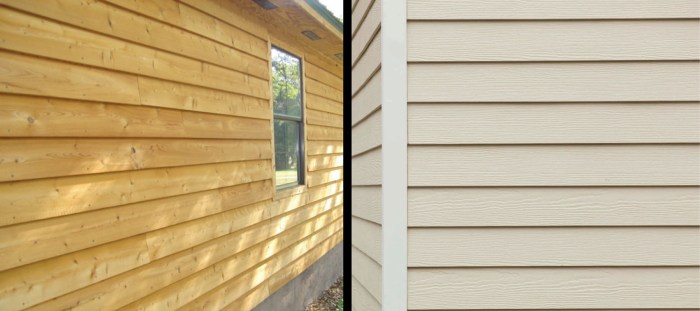Wood siding vs vinyl siding sets the stage for this enthralling narrative, offering readers a glimpse into a story that is rich in detail and brimming with originality from the outset.
As we delve into the characteristics, aesthetics, cost considerations, and environmental impact of wood siding versus vinyl siding, a fascinating comparison emerges, shedding light on the pros and cons of each material.
Overview of Wood Siding and Vinyl Siding

Wood siding is a traditional choice for homes, known for its natural beauty and classic appeal. It is usually made from cedar, pine, or redwood, giving it a warm and inviting look. Wood siding can be painted or stained in various colors to match the aesthetic of the house.Vinyl siding, on the other hand, is a more modern option that has gained popularity for its low maintenance and durability.
It is made from PVC (polyvinyl chloride) resin and comes in a wide range of colors and styles. Vinyl siding is known for its affordability and ease of installation.
Characteristics of Wood Siding
- Natural and classic appearance
- Can be painted or stained
- Requires regular maintenance such as painting or sealing
- Susceptible to rot, mold, and insect damage
Properties of Vinyl Siding
- Low maintenance and long-lasting
- Available in various colors and styles
- Resistant to rot, mold, and insect damage
- Easy to clean with just soap and water
Comparison of Durability
Wood siding is more prone to damage from moisture, insects, and rot compared to vinyl siding. Vinyl siding is known for its durability and can last for several decades without needing replacement.
Maintenance Requirements
Wood siding requires regular maintenance such as painting or sealing to protect it from the elements. On the other hand, vinyl siding is low maintenance and only requires occasional cleaning with soap and water to keep it looking fresh.
Aesthetics and Design
Wood siding has a timeless and natural aesthetic appeal that adds warmth and character to a home. Its organic texture and earthy tones create a cozy and inviting look that many homeowners find appealing. The natural beauty of wood can enhance the overall curb appeal of a house, giving it a rustic or traditional charm.
Wood Siding Design Options
Wood siding offers a wide range of design options, including horizontal clapboard, vertical board and batten, shingle, and shake styles. Each style provides a unique look and can be customized to suit different architectural preferences. Additionally, wood siding can be stained or painted in various colors to match the homeowner's desired aesthetic.
Vinyl Siding Color Choices and Styles
Vinyl siding comes in a plethora of color choices and styles, ranging from traditional neutrals to bold and vibrant hues. Homeowners can choose from options that mimic the look of wood, stone, or other materials, allowing for a versatile selection to complement different architectural styles.
Vinyl siding is also available in various textures to add depth and dimension to the exterior of a home.
Complementing Architectural Styles
Wood siding is often associated with classic and traditional architectural styles, such as Colonial, Craftsman, and Cape Cod homes. Its natural appeal blends seamlessly with these designs, enhancing the overall aesthetic of the house. On the other hand, vinyl siding is versatile and can complement a wide range of architectural styles, from modern and contemporary to farmhouse and ranch.
Its flexibility in color and style options makes it a popular choice for homeowners looking to achieve a specific look for their home.
Cost Considerations
When deciding between wood siding and vinyl siding, cost is a significant factor to consider. The initial cost of installation, as well as the long-term expenses, can vary between the two options. Additionally, understanding any cost-saving benefits associated with each type of siding is crucial for making an informed decision.
Initial Cost Comparison
When it comes to the initial cost of installation, vinyl siding is generally more affordable than wood siding. The materials for vinyl siding are typically cheaper, and the installation process is often quicker and requires less labor. On the other hand, wood siding tends to be more expensive upfront due to the higher cost of materials and the skilled labor needed for installation.
Long-Term Cost Implications
While vinyl siding may have a lower initial cost, it is essential to consider the long-term cost implications. Vinyl siding may require more frequent replacements or repairs compared to wood siding, which can add up over time. Wood siding, although initially more expensive, can be more durable and may require less maintenance in the long run, potentially saving costs on repairs and replacements.
Cost-Saving Benefits
One cost-saving benefit of vinyl siding is its lower maintenance requirements. Vinyl siding is generally easier to clean and does not require painting or staining, saving time and money on upkeep. However, wood siding can also offer cost-saving benefits in the long term due to its durability and potential longevity with proper maintenance.
Investing in high-quality wood siding upfront can result in fewer repair costs over time.
Environmental Impact
Wood siding and vinyl siding both have distinct environmental impacts that should be considered when choosing between the two options. Wood siding is often seen as a more sustainable choice due to its biodegradability and renewable nature. On the other hand, vinyl siding is made from synthetic materials that are not biodegradable and can release toxins during production and disposal.
Sustainability of Wood Siding Materials
Wood siding is considered sustainable because it is a renewable resource that can be harvested responsibly. When sourced from well-managed forests, wood siding can be a more environmentally friendly option compared to vinyl. However, it is essential to ensure that the wood used is certified by organizations like the Forest Stewardship Council (FSC) to guarantee sustainable forestry practices.
Eco-Friendly Options in Vinyl Siding
While vinyl siding is not inherently eco-friendly due to its synthetic composition, there are some environmentally conscious options available. Some manufacturers offer recycled vinyl siding, which reduces the overall environmental impact by reusing materials. Additionally, certain vinyl siding products are designed to be more energy-efficient, helping to lower overall energy consumption in a home.
Energy Efficiency of Wood Siding and Vinyl Siding
When it comes to energy efficiency, wood siding typically offers better insulation properties compared to vinyl siding. Wood naturally provides thermal insulation, helping to regulate indoor temperatures and reduce the need for heating and cooling. On the other hand, vinyl siding may require additional insulation layers to achieve the same level of energy efficiency, adding to the overall environmental impact.
Outcome Summary
In conclusion, the debate between wood siding and vinyl siding presents homeowners with a choice that goes beyond mere aesthetics. Consider the durability, maintenance, cost implications, and environmental factors before making your decision, as both options have their unique advantages and drawbacks.
Questions and Answers
Is wood siding more expensive than vinyl siding?
Wood siding typically has a higher initial cost compared to vinyl siding, but the long-term cost implications may vary depending on maintenance needs and durability.
Which siding is more environmentally friendly?
Wood siding is often considered more environmentally friendly due to its natural composition and sustainability, although there are eco-friendly options available in vinyl siding as well.
Can vinyl siding mimic the look of wood siding?
Yes, vinyl siding comes in a variety of styles and colors that can closely resemble the appearance of wood siding, offering homeowners more design options.













